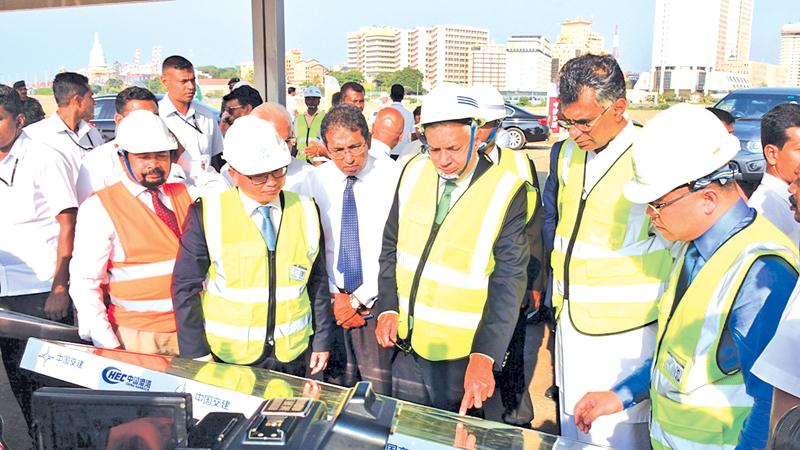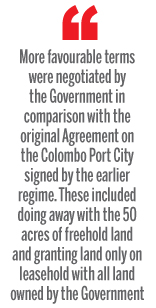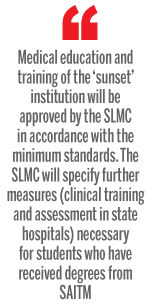
 Last week, Prime Minister Ranil Wicrkremesinghe visited the Port City site, which has reached the 60 percent mark of its reclamation work and is now gearing up for the next stage.
Last week, Prime Minister Ranil Wicrkremesinghe visited the Port City site, which has reached the 60 percent mark of its reclamation work and is now gearing up for the next stage.
He was accompanied by Megapolis and Western Province Development Minister Patali Champika Ranawaka, Finance State Minister Eran Wickremaratne, Deputy Minister Harsha de Silva and several other senior state officials.
“Having revoked the ‘sovereign rights’ the Chinese were given by the former regime and renegotiated the contracts, the Port City work is progressing well,” Dr. Harsha de Silva said, following the visit.
 “When one has sovereign rights over a territory it belongs to them completely; like in the case of an embassy. We also got rid of the F1 track and all the ego projects, and are now creating a financial centre plus other productive entities. We also completely overhauled the environmentally sensitive dredging plans as well,” the Deputy Minister explained, reiterating the current government’s position on the project.
“When one has sovereign rights over a territory it belongs to them completely; like in the case of an embassy. We also got rid of the F1 track and all the ego projects, and are now creating a financial centre plus other productive entities. We also completely overhauled the environmentally sensitive dredging plans as well,” the Deputy Minister explained, reiterating the current government’s position on the project.
By the latter part of 2018, building construction work on the flat top of the extra 269 acres allocated to the Colombo Business District is set to begin. On top of the committed investment, the value of the new buildings that would start construction later this year is estimated at over Rs 100 billion. This will take Sri Lanka in an entirely new direction where its vision and development are concerned.
Daunting task
Getting this project on track has been a daunting task for the Yahapalanaya government - especially, the Prime Minister who was first seen by some as an opponent of Colombo Port City.
While the local media had its way in creating negative vibes about the project, fueled by some NGO rhetoric that was strangely silent when the project commenced construction in 2014 under the previous Government, the Prime Minister stood firm on making certain drastic changes to the project structure, so that it could be fine-tuned into a city for future generations.
One significant factor was that the new Megapolis Ministry was put in charge of the project rather than the Sri Lanka Ports Authority (SLPA). More favourable terms were negotiated by the Government in comparison with the original Agreement on the Colombo Port City signed by the earlier regime. These included doing away with the 50 acres of freehold land and granting land only on leasehold with all land owned by the Government. Furthermore, public areas such as parks were expanded.
Former government
Former President Mahinda Rajapaksa when he was the Minister of Highways, Ports & Shipping formulated a cabinet paper in November 2013, initiating the Colombo Port City Development Project for luxury hotels and apartment complexes, shopping malls, spaces for modern offices for the corporate sector, leisure and recreational activities, such as, yacht marinas, formula tracks, etc., and recommended that the SLPA enter into an agreement with China Communication & Construction Company Limited (Project Company) on the basis of an unsolicited proposal to implement it.
The proposal was approved by the Cabinet of Ministers on January 13 2014.
Amendments
 After the formation of the new Government headed by President Maithripala Sirisena in March 2015, the construction work on the Port City was suspended pending a new supplementary environment impact assessment report to address the major shortcomings of the previous EIA approval process.
After the formation of the new Government headed by President Maithripala Sirisena in March 2015, the construction work on the Port City was suspended pending a new supplementary environment impact assessment report to address the major shortcomings of the previous EIA approval process.
However, since the previous Government had committed to obtaining environmental approvals as part of its responsibility, there was a possibility that the government would be exposed for losses caused due to suspension of construction.
After negotiations by both parties and discussions at political level by President Maithripala Sirisena and Prime Minister Ranil Wickremesinghe during their visits to China, both sides decided to settle the issue amicably.
The Cabinet of Ministers amended its decision on March 9 2016, permitting the resumption of the construction work of the project when the supplementary EIA was completed and on the issuance of a Development Permit with 40 or more conditions than the previous granted by the last Government.
A Committee of Secretaries appointed by the Cabinet was also instructed to hold discussions with a view to resolving issues pertaining to compensation. The Committee requested the project company to propose alternative ways instead of pursuing claims against the Government of Sri Lanka.
In addition, the Government further requested amendments to the Concession Agreement as the original agreement was unfavourable to Sri Lanka.
The important features of the new
Tri partite Agreement are :
1. Freehold Land - Original Agreement of September 2014 granted 20 hectares or 50 acres of land to the CHEC Port City (Pvt.) Ltd (the Project Company) on a freehold basis, with the balance of the land granted on a 99 year lease
- Under the current agreement all reclaimed lands will be vested with the Government and no extension of the lease beyond 99 years will be granted to the Project Company on its entire land entitlement. Also, the land to be leased to the project company for real estate development was reduced to around 43% of the total land reclaimed
2. Legal status of the land to be reclaimed:
- Under the original concessionary agreement, the status of the land was unclear. The SLPA Act would have to be amended for the SLPA to own land. Now the decision is that the land will be vested in the UDA but will be administered as a special economic zone with special laws to encourage a financial centre to be established
3. Utilities and transport Infrastructure
• Under the Original Agreement all investments in roads and utilities within the reclaimed area was the responsibility of the Project Company while providing all utilities and road infrastructure to the periphery of the site was the responsibility of the GOSL.
• Under the new agreement, the possibility of undertaking public-private-partnerships through the Project Company will be evaluated as a long term solution to ease GOSL’s responsibility of undertaking the provision of road infrastructure and utilities to the periphery of the site.
4. Limits imposed on developing GOSL lands
• The original Agreement placed restrictions on the type of developments that could be undertaken on the GOSL lands in the first 3 years after the reclamation. Under the new Agreement the above has been expanded in favour of the GOSL to include healthcare and hospitals, and exhibition and convention centres
• Also, no restriction will be placed on developing the proposed North and West Ports of the Colombo Harbour. In addition, the Project Company has agreed to setting up the CIFC building in the land area reclaimed first including making a new investment in the CIFC building no sooner it is technically feasible to build on reclaimed land and upon mutually acceptable terms being agreed with the GOSL after a feasibility study.
6. Changes to Master Plan and Land Allocation
• The previous administration had this as a Land Reclamation Project to utilize this initially for real estate, sports, education and cultural development, including night racing tracks, etc. Therefore, the bulk of the land was not available as general public spaces.
• The master plan has been redrawn as a Financial City without any night track racing, and adding public spaces such as, parks.
• The Project Company has also undertaken to carry out the feasibility study in consultation with the GOSL to construct the Financial City Corporation headquarters building which will include an international financial centre, with terms to be agreed by both parties after the feasibility study is conducted.
• It has been agreed with the Project Company that the land being used to build a Financial City, is to fill the vacuum for such a set up between Singapore and Dubai. The Financial City will enable offshore operations and for this purpose, the Government will propose new laws The Financial City is expected to become a major income earner and an employment provider for Sri Lanka.
7. Environmental Approvals
• There were short-comings in the environmental approvals obtained by the former administration of the SLPA
• A comprehensive new Supplementary Environmental Impact Assessment (SEIA) was carried out by the Ministry of Megapolis in 2015 to address such shortcomings
The SEIA took into account the altered design comprising an area of 269 ha, together with the impacts of extraction of sand from the identified barren areas and quarry material required for the entire landfill and protective works. The EIA carried out by SLPA in 2014 for 200ha did not cover environmental impacts of sand extraction and this lacuna was addressed via the SEIA study. The new SEIA study carried out by the Megapolis Ministry covered the entire reclamation footprint and the extraction of quarry material and sand required for the entire project.
The second Environmental Impact Assessment Study (EIA) carried out in October last year and released for public comment in November was for development activities and infrastructure facilities within the reclaimed land area of Colombo Port City. This included the infrastructure of buildings, utilities, procedures for disposal of waste water and solid waste, transport and traffic, landscaping and aesthetics, storm water management etc.
Internationally, a 2-stage EIA is a recognized approach. In the Netherlands, a 2-stage approach was followed for the recent expansion of the Port of Rotterdam by 2,000 hectares (the so-called “Maasvlakte II” project). The first EIA was for the “realization phase” of the land reclamation, covering coastal impact, dredging practices, etc. The second EIA was for the “development phase” analyzing the impact on the environment of the new activities within the port.
The Colombo Port City’s second EIA of 2017 unlike the previously conducted SEIA that attracted 220 written responses, evoked only 2 responses i.e. from a representative for People’s Movement against Port City and the Center for Environmental Justice.
SAITM
The SAITM issue was brought to a rest with the government’s announcement that it would be permanently abolishing SAITM in a manner legally acceptable to the current shareholders, lending institutions and the new entity interested in taking over all operations and management of SAITM, via the transfer of all SAITM’s assets, liabilities, staff and students to a non-state, not-for-profit degree-awarding entity that complies with the minimum standards of Medical Education and Training.
The solution would be two-pronged i.e. a new not-for-profit ‘sunset’ institution that will absorb all students who were in SAITM’s medical program, as well its assets and liabilities; at which point SAITM will be abolished.
The sunset institution will conclude operations when the last current batches of students graduate with no new students being admitted to this entity. Secondly, there will be the introduction of a new not-for-profit ‘sunrise’ institution that will start accepting new students from 2019. This is set to resolve concerns raised regarding SAITM, such as SAITM’s inability to meet Sri Lanka’s high standards for medical education and SAITM’s profit motive perverting the creation of good doctors.
The Sri Lanka Medical Council (SLMC), which establishes and maintains national standards for the medical profession, proposed a thorough set of Minimum Standards for Medical Education and Training that was accepted by the Cabinet with minor amendments on December 13 2017. This filled a major void in ensuring high standards of medical education.
Medical education and training of the ‘sunset’ institution will be approved by the SLMC in accordance with the Minimum Standards. The SLMC will specify further measures (clinical training and assessment in state hospitals) necessary for students who have received degrees from SAITM, to meet these standards and thereby gain Provisional Registration. The SLMC will grant fresh approval for the ‘sunrise’ institution upon its meeting Minimum Standards, through an institutional review and site visits as per their mandate and standard practice for this purpose.
The ‘sunrise’ institution will not operate for profit, and will be an institution limited by guarantee that charges fees, but re-invests any excess income over expenditure in the institution, including in the provision of scholarships based on financial need. SLIIT is an ideal partner in this effort, with two decades of experience in providing high-quality, not-for-profit higher education.
Additionally, the Neville Fernando Teaching Hospital will be transferred to the Ministry of Health, allowing the State medical sector to gain a Rs. 3.2 billion assets at no cost to the State.
The solution has the unanimous approval of the 9-member Committee, chaired by Harsha de Silva, Deputy Minister of National Policies and Economic Affairs, and includes the Secretaries to the Ministries of Health, Nutrition and Indigenous Medicine, and of Higher Education and Highways; President of the SLMC; Chairman of the University Grants Commission; Vice Chancellors of the Universities of Colombo and Sri Jayewardenepura; and Medical Faculty Deans of the Universities of Colombo and Kelaniya. This Committee met thrice to debate and improve this solution, with the participation of the Association of Medical Specialists, Sri Lanka Medical Association, Government Medical Officers’ Association, Federation of Faculty Medical Teachers’ Association, Government Medical Students’ Parents’ Association, and SAITM Medical Students’ Parents’ Association, as observers.
The ball is now in the court of the new entity to make this a success. The institution will be initially challenged by the huge financial burden it takes on and according to some financial sources, it would take almost 20 years for them to settle the banks of liabilities, including loans amounting to Rs. 2.5 billion. Any surpluses from the medical degree programs they would run could only happen after this. Therefore, despite the fact that this issue has been brought to a rest, it is probably not the best outcome for everybody - it is more a case of being the best solution in a real world. Life is mostly about compromise and learning to deal with things that cannot be changed.
